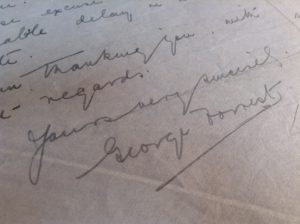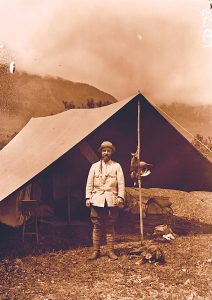Pauline Maclean, an RBGE Volunteer, writes:
“… By now you must be aware of the fact that I am no writer. As a practical worker I am a good average, but when it comes to romancing re scenery, incidents… I’m nowhere. It is not that I am unobservant, or that I do not appreciate the beauties of nature, quite the reverse. I think most often I feel too intensely for words, on such occasions words fail me, seem bald and unsatisfactory.” [George Forrest]
Having read through and listed just over 700 items from the Forrest correspondence (5 of the 10 boxes held in the RBGE Archive) I have to disagree with his assessment of his own writing abilities. The early letters, written on his first expedition (1904-07), give lengthy and very vivid accounts of the place and people that he encountered. There are detailed descriptions of the town of Tali (Dali), its walls, marble production and burial places, the dress and customs of the people, house construction, female make-up and clothing and foot-binding. As he travelled north towards Tibet, Forrest gives a lively description of a Tibetan house and wonders how the inhabitants of the plateau survive in winter, concluding that, as there is nothing to take them outside they “simply sit and snooze and smoke themselves over their pine and yak dung fires.”
Forrest wrote at great length – one early letter to his fiancee Clementina Traill extends to 50 pages and often he would begin a letter with “Just a note…” and then write 4 or 5 pages. In 1913 he wrote to his sponsor J.C. Williams of Caerhays Castle in Cornwall, “Had I more time at my disposal you would get more and better descriptions, but I have so many other things to attend to, that really I never have a full hour to myself. My evenings are given over to correspondence and though up at daybreak I seldom retire before eleven o’clock.”
George wrote regularly to Sir Isaac Bayley Balfour (RBGE Regius Keeper, 1888-1922) on matters botanical, relating his discoveries and their location, seeking advice on the identification of plants, outlining his labelling methods and listing the plants, seeds and photographs which he had dispatched. One consignment to Edinburgh contained a case of snakes (fortunately pickled!), destined for the Industrial Museum and now residing at the National Museum of Scotland.
While obviously of primary interest for their botanical content, Forrest’s letters contain much to interest other readers. He regularly comments on political matters both local, national and international. He writes of unrest on the frontiers, gives an account of the Talifu mutiny of 1913, expresses concern over Japan’s interference in Chinese affairs and, in spite of the fact that he was in the depths of China at the time, commenting on the outbreak of hostilities in Europe in 1914. The letters also contain regular references to the weather conditions and how these affected progress with his travels, plant collecting and photography. In August 1912 he sent home weather reports that had been collected by Customs staff at 5,000 feet and forwarded to Shanghai every week for over 4 years!
Thanks to the fact that J.C. Williams carefully noted the date of receipt of every letter from Forrest we can tell how long they took in transit which, in 1912-13 was between 3 and 9 weeks depending on how far up country he was when it was written.
There are so many wonderful passages in these letters. Botanists have long recognised the huge contributions that Forrest made to their science but his letters reveal so much more about the man himself and the countries and situations that he found himself in.
5 boxes listed, 5 more to go …



Prudence Roberts
Dear Ms. Mitchell,
I work at the National Herbarium of Trinidad & Tobago. For the period 1890 – 1920 Ms. Pauline McLean worked at the herbarium in the Royal Botanic Gardens, Port-of-Spain, Trinidad, West Indies and I have been searching for any record of her work during that period. A fire at the RBG many years ago burnt any records from that period. Can the Pauline MacLean that you write of be the same one that I am looking for??!! She lived in Belmont, Trinidad & Tobago. Any information would be greatly appreciated as I am trying to fill the historical gaps of the Herbarium’s development.